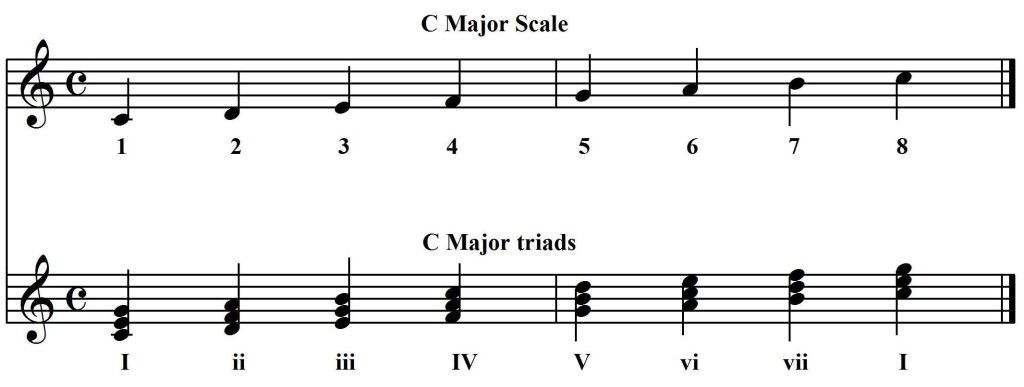How to Add Chord Substitutions: Final Lesson
Time to apply what was taught in lessons one through four on “How to Add Chord Substitutions”.
The following visual aid of the C Major scale and its chords will be helpful for this lesson!
Notice once again: The Major chords above are indicated by an upper case Roman numeral. The lower case Roman numeral indicates a minor chord.
Now for the fun part!…You’re about to learn how to find chord substitutions!
The bottom line: The three major chords listed above in the key of C: I, IV and V can be substituted with a minor chord. How do do this?
Look for a minor chord that has at least two notes in common with a major chord. For example: A iii chord (EGB) has two notes in common with the I chord (CEG). That means….a iii chord can replace a I chord in the right setting.
Ok….can you find the other minor chord that has two notes in common with the C (I) chord? Yes! the vi (ACE)
Your Quiz:
1. Find the two minor chords that have two notes in common with the IV chord.
2. How about the two minor chords that are compatible with the V chord?
~~~~~~~~~~~~~~~~~~~~~~~~~~~~~~~~~~~~~~~~~~~~~~~~~~~~~~~~~~~~
So…when to use the chord substitutions? When a major chord lasts for two or more beats…there is time to use a minor chord substitution! The melody note also dictates which substituted chord will sound right. (Hint: The left hand plays the chord substitution and the right hand may have to alter the alto note to match the substituted chord. (When playing from the hymnal)
*Special note: (Observation from one of my readers)…Just go up or down two chords from a Major chord to find its minor chord substitutions. (Thanks Victoria!)
I will provide visual examples in the next article!
Tags: chord substitutions, Chords, major chord, minor chord

I’m so excited about this! I can’t wait to try it 🙂 Thanks for taking the time to explain it.
Correct me if I’m wrong… it’s not hard to find the compatible chords, because you just go two chords down the scale or two chords up the scale up to find them, correct? Thinking of it this way might be quicker when you’re actually in the middle of playing.
Yes…just go up or down two chords from a Major chord to find its minor chord substitutions 🙂
You implied there will be another article after the final lesson on “Chord Substitutions.” When will you post that on this site?
Hi Carol. Thanks for asking. I will be posting this article over Christmas break.
[…] These examples are in relation to the final lesson on chord substitutions. […]
[…] Answers from previous quiz questions for Chord Substitutions: […]